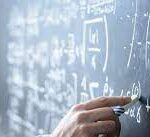Mathematicians hold about 3,100 jobs. The largest employers of mathematicians are as follows:
| Federal government | 35% |
| Research and development in the physical, engineering, and life sciences | 17 |
| Colleges, universities, and professional schools; state, local, and private | 16 |
| Finance and insurance | 8 |
| Management, scientific, and technical consulting services | 7 |
Statisticians hold about 37,200 jobs. The largest employers of statisticians are as follows:
| Federal government | 13% |
| Research and development in the physical, engineering, and life sciences | 11 |
| Insurance carriers and related activities | 9 |
| Healthcare and social assistance | 8 |
| Colleges, universities, and professional schools; state, local, and private | 8 |
Mathematicians and statisticians typically work in offices. They also may work on teams with engineers, scientists, and other professionals.
Mathematician and Statistician Work Schedules
Most mathematicians and statisticians work full time. Deadlines and last-minute requests for data or analysis may require overtime. In addition, these workers may travel to attend seminars and conferences.
How to Become a Mathematician or Statistician
Mathematicians and statisticians typically need at least a master’s degree in mathematics or statistics. However, some positions are available to those with a bachelor’s degree.
Education for Mathematicians and Statisticians
In private industry, mathematicians typically need an advanced degree, either a master’s degree or a doctorate. For jobs with the federal government, candidates need at least a bachelor’s degree in mathematics or significant coursework in mathematics.
Most colleges and universities offer a bachelor’s degree in mathematics. Courses usually include calculus, differential equations, and linear and abstract algebra. Many colleges and universities advise or require mathematics students to take courses in a related field, such as computer science, engineering, physics, or statistics. Because mathematicians often work with data analysis software, computer programming courses may be particularly beneficial for students.
Many universities offer master’s and doctoral degrees in theoretical or applied mathematics. Many students who get a doctoral degree work as professors of mathematics in a college or university.
Statisticians typically need a master’s degree but some entry-level positions may accept candidates with a bachelor’s degree.
Most statisticians have degrees in mathematics, economics, computer science, or another quantitative field. A degree in statistics typically includes courses in linear algebra, calculus, experimental design, survey methodology, probability, and statistical theory.
Many colleges and universities advise statistics students to take courses in a related field, such as computer science, engineering, or physics. These courses can help prepare students to work in a variety of industries. Coursework in engineering or physical science, for example, may be useful for mathematicians or statisticians working in manufacturing on quality or productivity improvement. A background in biology, chemistry, or health sciences is useful for work testing pharmaceutical or agricultural products.
Because mathematicians and statisticians often work with data analysis software, computer programming courses may be particularly beneficial for students.
Students who are interested in becoming mathematicians or statisticians should take as many math courses as possible in high school.
Important Qualities for Mathematicians and Statisticians
Analytical skills. Mathematicians and statisticians use mathematical techniques and models to analyze large amounts of data. They must determine the appropriate software packages and understand computer programming languages to design and develop new techniques and models. They must also be precise and accurate in their analysis.
Communication skills. Mathematicians and statisticians must interact with, and propose solutions to, people who may not have extensive knowledge of mathematics.
Math skills. Mathematicians and statisticians use statistics, calculus, and linear algebra to develop their models and analyses.
Problem-solving skills. Mathematicians and statisticians must devise new solutions to problems encountered by scientists or engineers.


